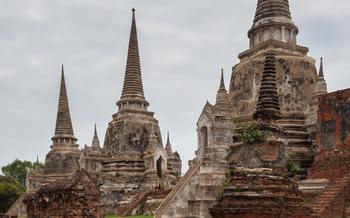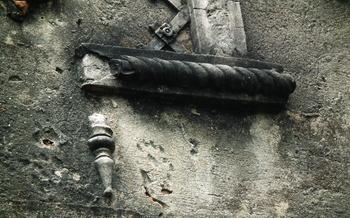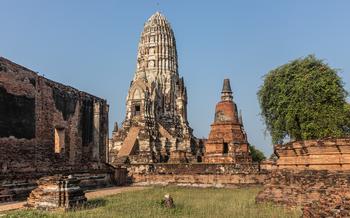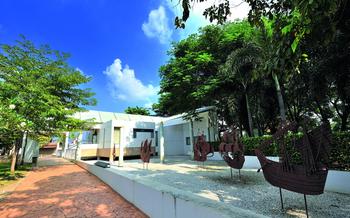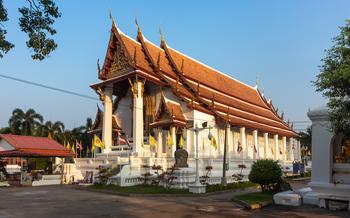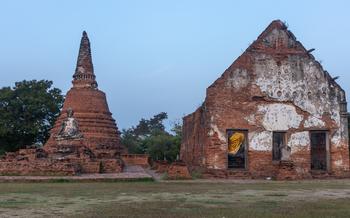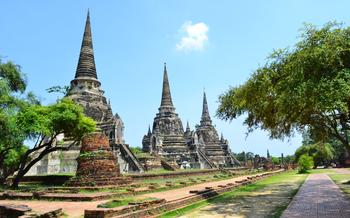
Wat Na Phra Men
- Exploring the Majestic Stupas
- Marveling at the Buddha Images
- Strolling Through the Temple Grounds
- Learning About Ayutthaya's History
- Visiting Nearby Attractions
- Budget and Accommodation
- Food and Dining Options
- Shopping and Souvenirs
- Photography Tips and Inspiration
- Cultural Etiquette and Respect
- Off-the-Beaten-Path Gems
- Volunteer Opportunities
- Safety and Security
- Insider Tip: Hidden Murals
Situated amidst the ancient city of Ayutthaya, Wat Na Phra Men stands as a testament to Thailand's rich cultural heritage. Built in the 14th century, this Buddhist temple holds immense historical and religious significance. It was once part of the grand royal palace complex and served as a place of worship for the Ayutthaya kings. The temple's intricate architecture, majestic stupas, and serene atmosphere make it a must-visit destination for anyone exploring the wonders of Ayutthaya.
History and Significance**
Wat Na Phra Men's history is intertwined with the rise and fall of the Ayutthaya Kingdom. Founded by King Ramathibodi I, the temple played a pivotal role in the kingdom's religious and political life. It was here that royal ceremonies and important events took place, solidifying the temple's status as a symbol of power and authority. After the fall of Ayutthaya, the temple fell into disrepair but was later restored and reopened to the public, allowing visitors to witness its enduring beauty and historical significance.
Architectural Features
Wat Na Phra Men's architectural style reflects the grandeur of the Ayutthaya period. The temple complex features a series of impressive stupas, intricate carvings, and well-preserved murals. The main stupa, known as the Phra Prang, rises majestically above the temple grounds, adorned with intricate stucco decorations and crowned by a towering spire. The surrounding viharns and ordination halls showcase a blend of traditional Thai and Khmer architectural elements, creating a harmonious and visually captivating ensemble.
Religious and Cultural Importance
Wat Na Phra Men holds deep religious and cultural significance for the Thai people. It is considered one of the most sacred temples in Ayutthaya and is visited by thousands of pilgrims and tourists each year. The temple is home to numerous Buddha images, including the highly revered Phra Buddha Na Phra Men, which is believed to have been created by King Ramathibodi I himself. Devotees come to the temple to pay respect to Buddha, make offerings, and seek blessings, ensuring that Wat Na Phra Men remains a vibrant and active center of Buddhist worship.
Exploring the Majestic Stupas
Wat Na Phra Men is renowned for its five majestic stupas, each possessing unique characteristics and profound religious significance. The largest stupa, known as Phra Prang, stands tall, symbolizing Mount Meru, the sacred mountain at the center of the Buddhist cosmos. Its intricate carvings and decorative elements depict scenes from the Buddha's life and teachings. The four smaller stupas, known as Phra Chedi, surround Phra Prang, representing the four cardinal directions and the four elements: earth, water, fire, and air.
These stupas are adorned with intricate stuccowork, featuring mythical creatures, floral motifs, and scenes from Buddhist mythology. Each stupa holds a relic of the Buddha, adding to their religious significance. Ancient legends and folklore surround these stupas, captivating visitors with tales of their creation and the miracles associated with them.
Photographers will delight in capturing the stupas' grandeur against the backdrop of the blue sky. Experiment with different angles and perspectives to showcase their towering height and intricate details. The best time to visit is during the golden hour, when the warm light casts a magical glow upon the stupas, creating a truly enchanting sight.
Marveling at the Buddha Images
Within the temple grounds of Wat Na Phra Men, visitors will be captivated by the diverse collection of Buddha images enshrined throughout the complex. These sacred representations of the Buddha come in various forms, sizes, and postures, each holding unique historical and cultural significance.
The most prominent Buddha image is the colossal bronze statue known as the Phra Mongkhon Bophit, which stands majestically in the main ordination hall. This revered image, created in the 16th century, exudes an aura of serenity and compassion, attracting pilgrims and visitors from far and wide.
Other notable Buddha images include the Phra Buddha Lokanat, a seated Buddha with a distinctive posture, and the Phra Buddha Chinnarat, renowned for its intricate and graceful features. These images embody the essence of Thai craftsmanship and artistic traditions, showcasing the devotion and artistry of the ancient Ayutthaya Kingdom.
Visitors are encouraged to pay respect and make offerings to the Buddha images, following local customs and traditions. These offerings, typically consisting of flowers, incense sticks, and candles, symbolize gratitude and devotion to the teachings of the Buddha. By observing these rituals, travelers can immerse themselves in the spiritual and cultural significance of Wat Na Phra Men.
Strolling Through the Temple Grounds
Wat Na Phra Men is a sprawling temple complex that offers visitors a tranquil and serene environment for contemplation and exploration. As you wander through the grounds, you will encounter various notable landmarks and features that contribute to the temple's unique character.
Take your time to admire the intricate architectural details of the temple buildings, which showcase the exquisite craftsmanship and artistry of the Ayutthaya period. The main ordination hall, or viharn, is a particularly impressive structure, with its soaring spires and elaborate carvings.
Within the temple grounds, you will find several Buddha images enshrined in various shrines and alcoves. These images range from small, intimate statues to towering, majestic figures, each with its own unique story and significance. Pay your respects and make offerings to the Buddha images, following local customs and traditions.
As you explore the temple grounds, remember to be mindful of your behavior and dress code. Visitors are expected to dress modestly and respectfully, covering their shoulders and knees. It is also important to maintain a quiet and contemplative atmosphere, avoiding loud noises or disruptive behavior.
Wat Na Phra Men is a place of spiritual significance for many Thai people, and it is important to be respectful of their beliefs and customs. By observing proper etiquette and behavior, you can contribute to the preservation of this sacred space for future generations.
Learning About Ayutthaya's History
Ayutthaya, once the thriving capital of the Ayutthaya Kingdom, holds immense historical significance in Thailand. Founded in 1350, the kingdom flourished for over 400 years, leaving behind a rich legacy and cultural heritage. Wat Na Phra Men stands as a testament to this glorious past, offering visitors a glimpse into the kingdom's rise and fall.
During its golden age, Ayutthaya was a bustling center of trade and diplomacy, attracting merchants, envoys, and visitors from across the globe. The kingdom's strategic location along the Chao Phraya River facilitated commerce and cultural exchange, transforming it into a vibrant and cosmopolitan city. Ayutthaya's influence extended far beyond its borders, shaping the political, economic, and cultural landscape of Southeast Asia.
However, in 1767, the kingdom met its tragic end when the Burmese army invaded and sacked Ayutthaya, reducing the once-magnificent city to ruins. Despite its destruction, Ayutthaya's legacy lived on, inspiring future generations of Thais and serving as a reminder of their nation's rich history.
Wat Na Phra Men, with its well-preserved stupas and Buddha images, stands as a symbol of Ayutthaya's resilience and enduring spirit. Visitors to the temple can immerse themselves in the history of this ancient kingdom, gaining a deeper understanding of Thailand's cultural heritage and the factors that shaped its identity.
Visiting Nearby Attractions
While Wat Na Phra Men is a significant attraction in its own right, Ayutthaya offers a treasure trove of other historical and cultural sites that are worth exploring. To fully immerse yourself in the city's rich past, consider visiting these nearby attractions:
-
Wat Mahathat: Located a short distance from Wat Na Phra Men, Wat Mahathat is another must-visit temple in Ayutthaya. It is renowned for its iconic Buddha head entwined by tree roots, a poignant symbol of the city's resilience.
-
Wat Chaiwatthanaram: Situated on the banks of the Chao Phraya River, Wat Chaiwatthanaram is known for its unique Khmer-inspired architecture. Its towering prang and intricate carvings offer a glimpse into the artistic and cultural influences of the region.
-
Ayutthaya Historical Park: Declared a UNESCO World Heritage Site, Ayutthaya Historical Park encompasses the ruins of the ancient city. Explore the park's sprawling grounds to discover remnants of palaces, temples, and fortifications, providing a glimpse into the grandeur of the former capital.
-
Ayothaya Floating Market: Experience the vibrant local culture at Ayothaya Floating Market. Browse through stalls selling traditional Thai handicrafts, souvenirs, and delicious street food while enjoying a leisurely boat ride along the river.
-
Elephant Village: For a unique and memorable experience, visit Elephant Village, where you can interact with these gentle giants. Learn about their behavior and ecology, and even take a ride on an elephant's back through the surrounding countryside.
To make the most of your time in Ayutthaya, consider booking a guided tour or hiring a bicycle to explore the city at your own pace. With its rich history, stunning temples, and vibrant local culture, Ayutthaya offers an unforgettable experience for travelers seeking a glimpse into Thailand's glorious past.
Budget and Accommodation
When visiting Wat Na Phra Men and exploring Ayutthaya, budget-conscious travelers have a range of affordable accommodation options to choose from. Guesthouses and hostels provide a comfortable and social environment for backpackers, starting from as low as 10-15 USD per night. These budget-friendly lodgings often offer shared dormitories, private rooms, and basic amenities like Wi-Fi, lockers, and shared kitchens. For a slightly higher budget of around 20-30 USD per night, visitors can opt for mid-range hotels or guesthouses with private rooms, air conditioning, and additional facilities. These options provide a balance of comfort and affordability, catering to travelers who seek a more private and convenient stay.
For those seeking a luxurious and indulgent experience, Ayutthaya offers a selection of upscale hotels and resorts. These high-end accommodations typically start from 50 USD per night and feature spacious rooms, balconies with stunning views, swimming pools, fitness centers, and other premium amenities. Whether you're a budget backpacker, a mid-range traveler, or a luxury enthusiast, Ayutthaya has something to offer every visitor, ensuring a comfortable and memorable stay.
Food and Dining Options
Wat Na Phra Men is surrounded by a variety of local restaurants and street food stalls, making it easy for visitors to grab a bite to eat before or after exploring the temple. From traditional Thai dishes to international cuisine, there are plenty of options to satisfy every palate.
Some must-try Thai dishes in Ayutthaya include pad thai, a stir-fried rice noodle dish with vegetables, egg, and peanuts; khao soi, a northern Thai curry noodle soup with coconut milk and crispy noodles; and boat noodles, a flavorful soup with beef or pork, noodles, and vegetables.
For vegetarians and vegans, there are several options available as well. Many restaurants offer tofu or vegetable-based versions of popular Thai dishes, and there are also a number of vegan restaurants in the city.
If you're looking for a more immersive experience, you can take a cooking class to learn how to prepare traditional Thai cuisine. Several cooking schools in Ayutthaya offer classes for both beginners and experienced cooks, and you'll get to enjoy the delicious results of your labor at the end of the class.
Shopping and Souvenirs
Wat Na Phra Men and its surroundings offer a delightful shopping experience for visitors who wish to take home unique souvenirs and handicrafts. Within the temple grounds, you'll find small shops selling a variety of items, including Buddha images, amulets, and religious artifacts. These items hold cultural and spiritual significance, making them treasured keepsakes for many visitors.
Strolling through the nearby markets, you'll discover an array of local products and handicrafts. From intricate wood carvings and colorful textiles to handmade jewelry and pottery, there's something for every taste and budget. Bargaining is a common practice in these markets, so don't be afraid to haggle to get the best price.
If you're looking for unique and authentic items, consider visiting the local artisans' workshops. These workshops showcase the skills of local craftsmen and women who create exquisite handmade products using traditional techniques. You'll find everything from hand-woven scarves and bags to intricately carved wooden sculptures. Supporting these artisans not only ensures you get a one-of-a-kind souvenir but also helps preserve local traditions and livelihoods.
Photography Tips and Inspiration
Wat Na Phra Men offers a treasure trove of photographic opportunities for capturing the essence of this sacred site. To maximize your shots, aim to visit during the early morning or late afternoon to take advantage of the soft, golden light that casts a magical glow on the stupas and temple grounds. Experiment with different angles and perspectives to highlight the grandeur of the architecture and the serene atmosphere. Don't forget to capture the intricate details of the Buddha images and the symbolic motifs adorning the temple walls. For Instagram-worthy shots, seek out the colorful prayer flags fluttering in the breeze, the rows of lotus flowers blooming in the ponds, and the friendly monks engaged in their daily rituals.
Cultural Etiquette and Respect
When visiting Wat Na Phra Men and other temples in Thailand, it's essential to be mindful of Thai customs and traditions. Proper attire is expected, with visitors advised to wear modest clothing that covers their shoulders and knees. Removing shoes before entering the temple is a sign of respect, and visitors should refrain from pointing their feet towards Buddha images. Making offerings to the Buddha is a common practice, and visitors can purchase flowers, incense, or candles from vendors outside the temple. When making offerings, it's customary to kneel or sit in a respectful manner. Engaging with local monks and other visitors should be done with a polite and respectful demeanor.
Off-the-Beaten-Path Gems
Venturing beyond the main temple grounds, explore the hidden corners of Wat Na Phra Men to uncover its lesser-known treasures. Discover secluded meditation chambers adorned with intricate carvings, or stumble upon ancient Buddha images nestled amidst lush vegetation. Each hidden spot offers a unique glimpse into the temple's rich history and spiritual significance.
Take time to explore the surrounding area as well. Just a short walk away, you'll find a vibrant local market teeming with vendors selling fresh produce, handmade crafts, and delicious street food. Engage with the friendly locals, sample the exotic fruits, and immerse yourself in the vibrant atmosphere.
If you happen to visit during a local festival or event, be sure to join in on the festivities. Ayutthaya hosts a variety of cultural celebrations throughout the year, offering a chance to witness traditional Thai performances, partake in colorful processions, and experience the infectious energy of the local community.
To deepen your cultural immersion, strike up conversations with local monks and other visitors. Inquire about the temple's history, their personal experiences, and their insights into Thai Buddhism. These interactions will provide a unique perspective and a deeper understanding of the local culture.
Whether it's exploring hidden murals, discovering local markets, partaking in festivals, or engaging with the community, there's always something new to uncover at Wat Na Phra Men and its surroundings. Embrace the spirit of adventure and let yourself be surprised by the hidden gems that await.
Volunteer Opportunities
Wat Na Phra Men and the surrounding community offer various opportunities for travelers to give back and contribute to the preservation of this historic site. Visitors can participate in temple restoration projects, helping to maintain and restore the temple's structures, murals, and artifacts. These projects often involve cleaning, painting, and repairing various elements of the temple, contributing directly to its upkeep and preservation.
Another way to volunteer is by teaching English or other skills to local children. Many organizations in Ayutthaya work with local schools and communities to provide educational support. Volunteers can share their knowledge, skills, and experiences with Thai children, helping to improve their education and opportunities.
Moreover, there are community service initiatives that visitors can participate in, such as helping with local environmental projects, working in soup kitchens, or assisting with community development projects. These initiatives provide a unique opportunity to engage with the local community, learn about Thai culture, and make a positive impact on the lives of others.
Volunteering at Wat Na Phra Men and in Ayutthaya is a rewarding experience that allows travelers to connect with the local community, contribute to the preservation of Thailand's cultural heritage, and make a meaningful difference during their travels.
Safety and Security
Ayutthaya is generally a safe city for travelers, but it's essential to exercise caution and common sense, as with any destination. Here are some safety tips to keep in mind:
- Be aware of your surroundings and avoid walking alone at night, especially in secluded areas.
- Keep your valuables secure and don't flash large amounts of cash.
- Be wary of scams, such as tuk-tuk drivers offering inflated prices or tour guides asking for excessive fees.
- Refrain from engaging in illegal activities or substances, as the penalties can be severe.
- Respect local laws and regulations, including those related to visa requirements and customs restrictions.
- Keep emergency contact information and resources handy, such as the local police station and embassy details.
By following these simple safety measures, you can ensure a safe and enjoyable visit to Ayutthaya.
Insider Tip: Hidden Murals
Beyond the stupas and Buddha images, Wat Na Phra Men holds a hidden treasure waiting to be discovered: intricate murals adorning the temple's corridors. These murals, often overlooked by visitors, offer a glimpse into the rich history and mythology of Ayutthaya.
Crafted by skilled artisans centuries ago, the murals depict scenes from Buddhist scriptures, royal ceremonies, and traditional Thai folktales. Each stroke and color tells a story, showcasing the artistic prowess and cultural heritage of the Ayutthaya Kingdom.
To find these hidden gems, explore the corridors connecting the temple's main structures. Look for sections with dimly lit walls, as the murals may have faded over time. Use a flashlight or your phone's torch to illuminate the details, bringing the characters and scenes to life.
As you uncover these hidden treasures, take your time to appreciate their beauty and historical significance. These murals are not just works of art; they are windows into the past, allowing us to connect with the beliefs, values, and traditions of the Ayutthaya people.
Remember to be respectful and avoid touching or damaging the murals. These delicate artworks are irreplaceable and should be preserved for future generations to enjoy and appreciate.
